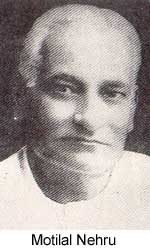

 |  |
There was a complaint at a students meeting Gandhiji addressed in Madurai that Khadi was too costly. Gandhiji retorted that the answer lay in wearing, less clothes and, from that day, discarded his dhoti and kurta in favour of a langot. For the rest of his life, he remained a 'half naked fakir'.  In July 1921, a new challenge was thrown to the Government Mohammed Ali, at the All India Khilafat Conference held at Karachi on 8 July, declared that it was 'religiously unlawful for the Muslims to cotinue in the British Army' and asked that this be conveyed to, every Muslim in the Army. As a result, Mohammed Ali, along with other leaders was immediately arrested. In protest the speech was repeated at innumerable meetings all over the country.
In July 1921, a new challenge was thrown to the Government Mohammed Ali, at the All India Khilafat Conference held at Karachi on 8 July, declared that it was 'religiously unlawful for the Muslims to cotinue in the British Army' and asked that this be conveyed to, every Muslim in the Army. As a result, Mohammed Ali, along with other leaders was immediately arrested. In protest the speech was repeated at innumerable meetings all over the country.The next dramatic event was the visit of the Prince of Wales which began on 17 November, 1921. The day the Prince landed in Bombay was observed as a day of hartal all over the country. In Bombay Gandhiji himself addressed a mammoth, meeting in the compound of the Elphinstone Mill owned by the nationalist Umar Shobhani, and lighted a huge bonfire of foreign cloth. Unfortunately, however, clashes occurred between those who had gone to attend the welcome function and the crowd that was returning from Gandhiji's meeting. Riots followed, in which Parsis, Christians, Anglo-Indians became special targets of attack as identifiable loyalists. There was police firing, and the three-day turmoil resulted in fifty-nine dead. Peace returned only after Gandhiji had been on fast for three days. The Prince of Wales was greeted with empty streets and downed shutters wherever he went. Emboldened by their successful defiance of the Government, non-cooperators became more and more aggressive. next page >> |
Copyright ©2000 indiansaga.info. All rights reserved.
By using this service, you accept that you won't copy or use the data given in this website for any commercial purpose.
The material on indiansaga.info is for informational & educational purpose only.
This site is best viewed at 800 X 600 picture resolution.